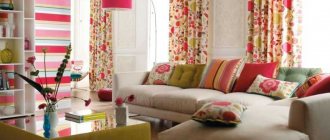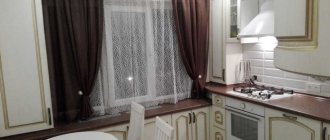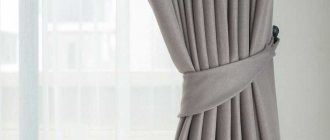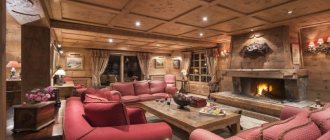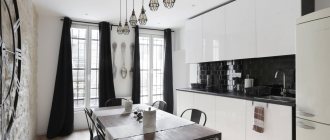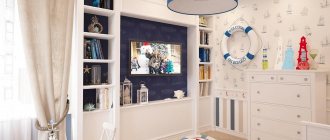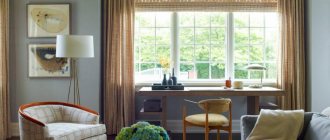Roman blinds are a fabric that covers a window opening, when raised, horizontal folds up to 30 cm wide are formed. This method of decoration is used when decorating offices, restaurants, cafes, apartments, and private houses. Depending on the purpose of the room and the characteristics of its operation, Roman blinds with or without tulle are used.
Roman blinds and their features
Structurally, such curtains are a rectangular canvas. Rods are inserted into it, forming folds at equal distances relative to each other. To make the structure heavier, a metal strip is inserted into the pocket at the bottom. When raised, it looks like a lambrequin: the fabric is gathered into folds, but remains lowered from the eaves by 25-40 cm.
Similar to roller blinds, the lifting mechanism can be controlled manually or remotely. In the second case, a remote control, portable gadgets with specialized software, or a stationary button are used to adjust the position of the canvas. This control option is the best solution when access to window openings is limited. Automation will make it easier for children and elderly people to raise or lower curtains.
Advantages and disadvantages
For designers, the arguments in favor of using Roman blinds when decorating rooms are the wide range of choice available. You can purchase a plain or colored version, decorated with embroidery, and combine it with finishing materials in the room and details from other textiles. Additional reasons for choosing this solution are the following facts:
- Versatility. It is possible to use canvas of any size and decorate non-standard window openings.
- Easy to control the position of the canvas. Adjusting the light level requires minimal effort.
- Space saving. This is how these curtains differ from classic curtains.
- Easy to care for. The fabric can be washed in an automatic machine or by hand. To do this, just remove it from the slats.
- Practicality. Curtains have a long service life and are resistant to fading, so most often the reason for replacement is the desire to update the interior design.
Among the shortcomings, users note the inability to quickly open an overview from the window. Especially if the curtains consist of several parts. The same thing happens when you need to open the sash for ventilation.
Varieties of Roman blinds
In the traditional design, curtains have a rigid plastic or wooden frame, which helps form clear, even folds when lifted. Products are produced without transverse rods, which results in the formation of waves that sag in the center of the canvas.
Options with an overlap differ from analogues in that in the open position the canvas consists of voluminous folds, fixed with thick tape on the back side. Depending on the design of the bottom of the product, manufacturers offer models with piping, lace trim, tassels, bugle bead decor, and braid. This design solution makes the appearance more impressive.
Types by light transmittance
The main purpose of curtains is to protect the room from intense sunlight. The ability to block ultraviolet radiation depends on the characteristics of the fabric. Taking into account the purpose of the room, canvases with different levels of light transmission are chosen. The correct choice of fabric density makes it possible to avoid problems with backlighting on the TV screen and sunlight penetrating the house in the morning.
The bedroom periodically needs complete darkness, so black-out fabrics, jacquard, vinyl, and satin will be a good solution. Their added benefit is their ability to reflect heat, keeping you cool on summer days. Thick curtains block up to 60% of ultraviolet radiation. They provide excellent protection at night from bright street illumination. If you combine the main fabric with tulle, the light transmission of the entire structure will decrease by an additional 5-10%.
Modern Roman blinds - 35 photos
Before we move on to viewing photos of Roman blinds in the interior, let's figure out what they are. Classic Roman shades are a simple sheet of fabric that fits the size of the window and have sewn-in slats that allow the fabric to gather like a blind.
In addition, Roman blinds can be built into a window or mounted on a wall, and also decorated with fringe, beads, and ribbons.
Articles on the topic (click to view)
- Photo curtain for the kitchen
- Kitchen interior with black and white curtains
- Photos of beautiful curtains with eyelets
- Photo of voile curtains for the kitchen or living room
- Photo of a bedroom interior with beige curtains
- Tips on how to choose curtains for the bedroom: photos of interiors
- Curtains for an arch in the hall or kitchen
Quite often, Roman blinds are a general term for all types of short window curtains, which can not only have sewn-in strips, but can be assembled using vertical strips, pinned with clips and other methods. The following image will help you understand the different types of Roman and other blinds (Roman blinds are labeled "Roman"):
Agree that Roman blinds are much more convenient than their relatives: they rise and fall with one movement of the hand, and at the same time they do not wrinkle at all! Although we must pay tribute to the “Balloon” curtains - they look chic even in plain colors:
Now that we know how Roman blinds differ from other types, it’s time to start choosing their ideal design. Next you will see photos of different rooms decorated with Roman blinds in various styles.
Pay attention to how the design of these curtains fits into the overall appearance of the interior and is combined with curtains, pillows, bedspreads and other home textiles. Enjoy watching!
Material for production
To choose a fabric, you need to focus on the features of the style in which the room is decorated. The material must be practical, resistant to wear and fading. Compliance with these requirements is of particular importance if the curtain is located in places with a high probability of contamination (on a loggia, terrace, kitchen).
In production, fabric of different densities is used. For bedrooms it should be the largest. Jacquard, flock, silk, velvet, linen, and cotton are used to make fabric. Products made from woven fabric are increasingly being chosen. In living rooms and bedrooms, double curtains with a tulle layer are most often used, which has the main decorative function.
In this case, choose a plain material in neutral or contrasting colors. Tulle is also in demand in the kitchen, but in most cases its length only reaches the level of the window sill. This is due to safety requirements due to the proximity of the stove, sink, and work surface.
Combination in different rooms
You can use this solution for window decoration in the kitchen, in the living room, in the bedroom, in the nursery, as well as on the loggia.
For the bedroom, Roman curtains are indispensable, as with their help you can completely close the window, darkening the room. In addition, they create an atmosphere of coziness and comfort, creating twilight even in daylight. When choosing colors, you can combine them with bed linen or bedspread.
A combination of Roman blinds and tulle with a curtain can emphasize the style of the living room. Particular attention should be paid not only to the structure of the fabric, but also to the color scheme, so that together they form a single ensemble. You can choose a Roman curtain not only to match the main curtains, but also to match the walls. A tapestry can be used here.
You may also be interested in: Tulle curtains in the interior - tips for choosing curtains and tulle
In the kitchen, you can complement a tulle curtain set with a Roman curtain to match the furniture, walls or tablecloth, as well as other kitchen accessories. It is better to use natural or light synthetic material, as heavy fabric will visually reduce the kitchen space.
The advantages of Roman blinds are obvious: simplicity of form, ergonomics, the ability to be raised or lowered, and the ability to integrate into any interior. In addition, they do not require complex maintenance and can be easily removed and hung back.
Save
Save
Save
Drawings and colors
Depending on the interior design, Roman blinds can become a bright accent or a neutral element that performs a purely practical function. The first option is more often used when decorating rooms in a minimalist manner, choosing canvases with contrasting patterns, abstract patterns, and complementing the canvas with bright trim on the sides.
If tulle performs the main decorative function, and dense fabric serves to protect the room from sunlight, choose fabrics in beige, sand, and gray colors. You can choose plain materials that will serve as a background and support the overall concept of decorating the room.
Photo hunt: Roman curtains – 95 photos
1. Size: wider than the window opening
Make the Roman blind slightly wider than the window opening, and muffle the resulting light gaps with inserts made of thicker fabric.
Design: Lavka-Design; pcs ora Mezzola; floor tiles: Francisco Segarra by Peronda
2. By size: window opening
When placing a Roman blind across the width of the window opening, do not forget to allow excess for fabric shrinkage so that there are no gaps later.
Illustration: Roman curtains - photo of a bathroom in a country house
3. Transparency: opaque
The denser and more opaque material you choose for a Roman blind, the more reliable it is: do not forget about the weighting agent at the bottom of the curtain.
6. Transparency: transparent
In bright interiors that require an abundance of natural light, the use of single transparent Roman blinds is quite acceptable.
Illustration: Roman curtains - photos of such curtains in the interior
7. Intended use: as tulle
If daylight is too bright, complement sheer Roman blinds with a companion - regular curtains made of thick material.
Expert opinion
Romanova Ksenia Petrovna
Interior design expert and fabric store manager
9. Included: with another Roman blind
Play with contrasts - let thick and transparent linen Roman blinds coexist in the window opening.
10.
Included : with another Roman blind
And you can differentiate between two Roman blinds that are different in material and purpose due to their location at different levels - above the window as a whole and in the window opening.
Illustration: Roman blind - photo of such a curtain complete with a roller blind
12.
Included : with a roller blind
Don’t be afraid of unusual combinations: a fabric Roman blind can look great with a bamboo roller blind.
15. Size: for two windows at once
The temptation to make one large Roman blind for two windows at once is great, but problems may arise with finding fabric of the required width (standard - 1.5 meters).
16. Size: for two windows at once
If you couldn’t find a fabric for a Roman blind of the required width, you can use a trick: take the length as the width. Or use more than one canvas.
Table lamp: Tolomeo, Artemide
17. By size: for each sash
A separate Roman blind for each window sash will make the interior more dynamic: you can experiment with their color and roll them to different heights.
18. By size: for each sash
But the mechanism for installing Roman blinds into the opening can make it difficult to open the windows. For this case, you can make a special niche in which the curtains will be hidden, as in this Moscow apartment.
19. By type: soft, without twigs
Frameless Roman blinds, made without rods, are assembled in smooth folds, with “ears” on the sides.
Roman blinds in the photo – Lege Alto
20.
By type: soft, without rods
Frameless Roman blinds add lightness, ease and warmth to the interior. In addition, they are easy to manufacture.
21.
By type: soft, without rods
Roman blinds without slats fit perfectly into this apartment for travelers - well, why not sails on a ship?
Lamp: ZETTEL'Z 6, design. Ingo Maurer
23.
By type: soft, without rods
A distinctive feature of soft Roman curtains is “ears”, folds on the sides.
Table: Faceted Mirror;
carpet: Diamond Denim; mirror
: Glamor
28. By mounting method: under the ceiling
A single Roman blind can be fixed directly below the ceiling. Or you can provide a special niche in which it will be removed.
30.
By method of fastening : in the window opening
The method of fastening Roman blinds in the window opening frees up a lot of space that can be used wisely. For example, arrange a window sill for gatherings, like in this Moscow apartment.
31.
According to the method of fastening : in the window opening
To prevent Roman blinds from interfering with the ventilation and opening of the window, it is better to fix the cornice not close to the sashes.
Expert opinion
Romanova Ksenia Petrovna
Interior design expert and fabric store manager
33.
According to the method of fastening: above the window opening
. The cornice of a Roman blind is most often installed above the window opening. If there are curtains, you can align them.
Roman blinds: yellow curtain fabric from Simta, with a pattern – Eijffinger
44. By placement: on the door
Roman blinds can also be used to cover glass door leaves. This technique is appropriate in country houses and in marine-style interiors.
Ceiling Light: Clear Hall Lantern
46. By placement: in the bay window
And you can hide the cornice of Roman curtains in a special niche in the bay window, as in this children's room in London.
Length and dimensions
Depending on the dimensions of the window structure, the width of the Roman blind is 30-300 cm. When installing the cornice on the profile, the size of the fabric must exactly match the opening to prevent the formation of gaps. If the structure is mounted on a wall, the canvas is chosen 5-7 cm wider. The length is most often determined by the height of the window sill, but an individual order of the product up to the floor level is possible.
Curtains in the interior of rooms
Designers have created models from safe, practical materials. They are often combined with tulle; the color and texture should be combined with the details used in the interior. In the kitchen, mini-structures made of stain-resistant, safe material are installed for each of the window sashes.
They will be the best option when there is a storage system under the window, low furniture (floor-length curtains will get in the way), a workshop desk or a sink. They are installed on glass doors with a large glazing area. This allows you to avoid overloading the interior with textiles.
Roman blinds in different styles
Whatever style you decorate the interior of the room in, you can safely choose Roman blinds, as they will harmoniously fit into any design if you choose the right color and texture of the material.
You may also be interested in: Design of curtains in the Baroque style
Provence style for a kitchen or country house involves curtains made of natural fabrics with embroidery or printed patterns. When adding a Roman curtain here, you need to choose for it a fabric of the same density as for a set of curtains, and a color like tulle.
High-tech requires us to adhere to minimalism and strictly comply with the color scheme, so in this case, a Roman curtain will look good made from the same fabric as the main curtains.
A classic curtain, at first glance, so familiar and understandable, to combine it with a Roman blind will require more imagination and knowledge from you, since just hanging a strip of the same fabric will ruin the interior. Here it is better to use a lighter material or tulle color with embroidery to match the main curtains.
The English style makes it easy to play up the color scheme with stripes. For example, alternate tulle-colored stripes with curtain-colored stripes.
For each style, you can choose the right combination of Roman blinds with a set of curtains. It is not for nothing that, considered the most ancient, this curtain is still used by designers to this day. Although a fashionable finishing element, it is still practical and functional in a modern home.
Criterias of choice
When determining the design option, take into account the size of the window openings and installation method. The design may consist of one or several layers with different levels of light transmission. For fastening, a profile made of wood, plastic or aluminum alloy is used. The choice depends on the weight of the canvas. The practicality of the selected fabrics is important: resistance to fading (especially if they are planned to be placed on a window on the sunny side), the ability to retain their shape after washing.
It is advisable to use a wrinkle-resistant material with high wear resistance. One of the most easy-to-care solutions will be fabrics made from a mixture of synthetics and natural ingredients. Manufacturers offer models with different characteristics. Among them, all that remains is to choose the decorative design of the curtains.
We recommend looking at the article about how to curtain windows with tulle
Subtleties of choosing textiles
Expressive window decor can be created using different materials. The interior will become interesting and unique if the fabric matches the color, texture, and pattern.
Fabrics with patterns
In order for the window design to fit organically into the design of the premises, it is better to follow the designers’ recommendations:
- if the decor of the room and the decoration of surfaces is dominated by a light, monochromatic palette (white, beige, gray, light green, cream), then it is better to decorate the windows with Roman blinds with bright patterns (blue, turquoise, red, green, orange). It is advisable to use contrast in colors in kitchens, living rooms, and children's rooms. A cheerful play of colors will add cheerfulness, freshness, and originality to the premises;
The design of the curtains eliminates the accumulation of dust
- when ornaments and patterns predominate in the interior (carpets, wallpaper with prints, patterned furniture upholstery), then plain canvases of calm colors are hung on the windows. To create a calming atmosphere in a room, it is preferable to choose companion fabrics. That is, the shade/pattern of the curtains repeats the color of the furniture upholstery or some element of the pattern of the floor covering or fabric upholstery;
- A real fashion trend has become a combination of close shades of the same color (lime/pale green, blurry blue/sea green, light brown/terracotta). Such curtains are especially appropriate when decorating a nursery or bedroom. To prevent the rooms from looking boring, materials with small patterns are selected for the canvases;
- When choosing a pattern, the dimensions of the room are also taken into account. In spacious rooms it is appropriate to hang curtains with large patterns. The modest size of the premises will not be emphasized by textile fabrics with small patterns or thin stripes;
- to create an organic atmosphere, curtains are hung on the windows to support the mood and character of the room. For a country style design, light curtains with a check or stripe are suitable. A soft rustic interior in Provence style will be decorated with beige and pink curtains with small floral patterns. For a teenage room decorated in a modern style, you can choose curtains with fashionable prints.
The canvas is decorated with soft folds even when lowered
The basic rule that must be followed when choosing canvases with a pattern is that the fabrics should repeat the elements that are in the finishing materials of the room, in the textile design of the room (carpets, pillows, upholstery).
Main types of ornaments
In order not to get lost in patterns and ornaments, designers identify four main types of patterns that are applied to window textiles.
In bright orange color
- Stripes . They can be placed on curtains vertically, horizontally and diagonally. The advantages of striped textiles are a visual change in the geometry of the room. Vertical lines visually raise the ceiling and narrow the space. Horizontal stripes visually expand the room and windows. The width of the fabric stripes is also important. Wide stripes are suitable for spacious rooms, and narrow ones for small ones.
- The cage is a popular and common pattern (especially when decorating the kitchen and nursery). This pattern fits organically into the atmosphere of spacious kitchens designed in Scandinavian or country style. The most famous check is considered to be tartan, which combines red and green shades.
- Floral patterns on the curtains attract attention to the windows and unobtrusively bring freshness and a cheerful mood to the atmosphere. Colorful Roman blinds create a homely feel in the kitchen, bedroom or nursery. Small floral patterns fit best into the calm, rustic Provençal style.
- Custom prints or geometric patterns will elegantly fit into modern styles. Textile fabrics with strict patterns will look great in a living room or teenage room. Children will really like fabrics with pictures made using photo printing technology and depicting their favorite fairy-tale characters. Such curtains are mainly created to order.
Tip When choosing patterned curtains, you need to keep in mind that the pattern can be located throughout the entire canvas, at the bottom/top, or in the form of a border. Among designers, it is believed that the ideal option for any ornaments or patterns is a white canvas. Therefore, feel free to hang white curtains with original designs on the windows.
Roman blind design
The peculiarity of Roman blinds is that they elegantly and practically decorate a window either alone or in company with curtains and drapes made from different materials:
- The standard option is to cover the window opening only with a Roman blind. The canvas simultaneously serves as a window decoration and protects the room from sunlight. For offices and home libraries, thick curtains of plain colors are better suited . To emphasize the severity of the interior, to prevent the fading of books and furniture, textile fabrics of dark shades are selected. The color scheme is restrained - shades of brown, gray, blue, dark green. And in living rooms, kitchens, children's or bathrooms, you can install structures with translucent patterned fabrics. These materials will not greatly obscure the rooms and will bring a feeling of spaciousness and freshness;
Elegant and practical window decoration
- in the combined version, the canvas is installed in the window opening and primarily performs a protective function. Traditional curtains made from fabrics of different textures and densities will be excellent companions for Roman blinds. A thick Roman blind made of linen, cotton, or satin in combination with tulle attached to a cornice (fixed above the window opening) looks unusual. Interesting ensembles are obtained by selecting plain and patterned materials . To make the Roman blind seem inconspicuous, textiles in light, solid shades or to match the window frame are used. Such combined techniques for designing openings will look unusual when decorating living rooms, bedrooms, and children's rooms.
To ensure that rooms facing north retain a warm, soft atmosphere, window coverings are made from thin materials (cambric, chiffon, tulle, silk) in a light palette. But it is better to cover windows facing south with thick Roman blinds (linen, cotton, satin).
Suitable for windows of different shapes
